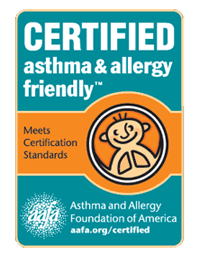April is National Healthy Homes Month. Your home can have a big impact on how well you manage your asthma and allergies. Reducing asthma triggers and allergens in your home should be an important part of your asthma and allergy management plan.
How Do I Know If I Have a Healthier Home?
Take this quick home assessment to see if you have allergy and asthma triggers lurking in your home that could be affecting your health:
- Do you have wall-to-wall carpeting?
- Do you have leaks under your sinks or mold in damp areas like your bathrooms and basement?
- Do you have a lot of fabric décor that can’t be washed, like throw pillows and blankets, heavy drapes, large area rugs, etc.?
- Have you had your mattresses longer than 10 years and your pillows longer than 2 years? Do you have allergen-barrier covers on them?
- Do you allow your pets in your bedrooms?
- Do you have piles of clutter collecting dust and pet dander?
- Do you open your windows during high pollen season or wear your shoes inside your home?
- Do you use scented candles, wax melts, plug-ins, or potpourri?
- Do you have signs of pests, like cockroaches or mice?
- Do you or anyone living in your home smoke?
If you answered yes to any of these items, you may have allergens and irritants that could affect your asthma and allergies. But thankfully, you can improve the overall health of your home.
How Can I Have a Healthier Home?
There are several steps you can take to improve the health of your home. If you aren’t sure where to begin, start by improving indoor air quality in your bedroom. You spend most of your time at home in your bedroom. And it tends to have more allergens than anywhere in your home. Then you can work on improving indoor air quality in other areas of your home, like the kitchen, living room, and the attic and/or basement.
To start a new habit of maintaining a healthier home, try these tips:
- Have everyone who lives in your home take their shoes off at the front door to avoid bringing in pollen.
- Wipe your pets off when they come inside to remove pollen and don’t allow your pets to go in your bedrooms.
- Keep your windows closed during high pollen seasons or when outdoor air quality is poor.
- Encase your mattresses and pillows in CERTIFIED asthma & allergy friendly® covers to reduce your exposure to dust mites.
- Wash your bedding and throw rugs weekly in water that is 130°F or hotter to remove dust mites and pollen.
- Reduce piles of clutter that can collect dust and pet hair.
- Vacuum carpet at least weekly with a CERTIFIED vacuum cleaner.
- Fix leaks and have mold cleaned.
- Don’t allow smoking in your home.
- Store your trash and food in airtight containers to prevents pests. Clean up spills and don’t leave food or dirty dishes on the counter.
- Use a CERTIFIED air filter in your HVAC unit to help reduce allergens in the air.
- Consider a CERTIFIED air cleaner to also reduce allergens in the air in your home.
There are many other ways you can improve the health of your home. Once you have made the changes above, check out other ways to continue to create a healthier home.
- Improve your indoor air quality and reduce allergy and asthma triggers room by room using our Healthier Home Checklist.
- Improve other areas of your home with National Healthy Homes Month tips from the U.S. Department of Housing and Urban Development (HUD).
 Many products promise to help control allergens but not all of them do. When you are shopping for products for your home, look for the CERTIFIED asthma & allergy friendly® mark. It indicates the product has passed our testing standards to help you have a healthier home.
Many products promise to help control allergens but not all of them do. When you are shopping for products for your home, look for the CERTIFIED asthma & allergy friendly® mark. It indicates the product has passed our testing standards to help you have a healthier home.Visit aafa.org/certified to search for CERTIFIED products. There you can also learn more about the asthma & allergy friendly® Certification Program.

Comments (11)